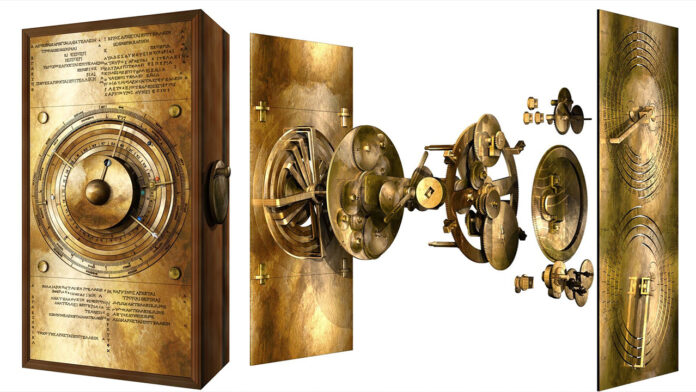In the depths of the Mediterranean, off the coast of the Greek island of Antikythera, a mysterious artifact was discovered in 1901 that would go on to baffle historians and scientists alike. This extraordinary piece of ancient technology, known as the Antikythera Mechanism, has been labeled by many as the world’s first computer. In this article, we embark on a journey to unravel the enigma of the Antikythera Mechanism, exploring its facts, historical context, and the technological prowess it represents.
Discovery of the Antikythera Mechanism
- Underwater Discovery: The Antikythera Mechanism was discovered by Greek sponge divers in 1901 amidst the wreckage of a Roman cargo ship that sank off the coast of Antikythera around 60 BCE.
- Complexity Unveiled: Initially mistaken for a piece of rock, the artifact was later found to be an intricate device with numerous gears, dials, and inscriptions, hinting at a level of sophistication not typically associated with the ancient world.
Ancient Technology Unveiled
- Astronomical Functions: Scientific analysis of the Antikythera Mechanism revealed its purpose as a sophisticated astronomical device. It was designed to predict celestial events, including solar and lunar eclipses, the positions of the planets, and the timing of major astronomical phenomena.
- Mechanical Engineering Marvel: The mechanical engineering behind the Antikythera Mechanism is astounding. It consists of a series of interlocking gears and rotating dials, showcasing a level of precision and craftsmanship previously thought to be beyond the capabilities of ancient Greek technology.
- Complex Gear System: The complexity of the gear system within the Antikythera Mechanism has been compared to the inner workings of a modern clock. Its gears are arranged to model the movements of the Sun, Moon, and planets in the night sky.
Historical Significance and Dating
- Dating the Artifact: The Antikythera Mechanism has been dated to approximately 150–100 BCE, making it a remarkable relic from the Hellenistic period. Its existence challenges previous assumptions about the technological capabilities of ancient civilizations.
- Greek Inscriptions: The device features Greek inscriptions, providing valuable information about its functions and the celestial events it was designed to track. These inscriptions contribute to our understanding of ancient Greek astronomy and engineering.
Theories and Speculations
- Origin and Creator: The exact origin of the Antikythera Mechanism and the identity of its creator remain unknown. While it is attributed to ancient Greek craftsmanship, the specific workshop or artisan responsible for its creation remains a subject of speculation.
- Use in Education: Some theories suggest that the Antikythera Mechanism might have been used as an educational tool for teaching astronomy, allowing students to visualize and understand the movements of celestial bodies.
- Lost Technological Legacy: The sophistication of the Antikythera Mechanism raises questions about whether other similar devices existed in the ancient world. Some speculate that there might be a lost technological legacy waiting to be discovered.
Modern Reconstructions and Studies
- X-Ray Imaging and 3D Modeling: Advanced technologies such as X-ray imaging and 3D modeling have been employed to study the internal structure of the Antikythera Mechanism. These techniques have revealed additional details about its intricate design.
- Reconstruction Efforts: Researchers and historians have undertaken ambitious projects to reconstruct the Antikythera Mechanism, creating functional replicas to better understand its operation and test various hypotheses about its use.
Cultural Impact and Legacy
- Revolutionizing Views of Ancient Science: The discovery of the Antikythera Mechanism has revolutionized scholarly views of ancient Greek science and technology. It challenges the perception of the ancient world as lacking in advanced mechanical and astronomical knowledge.
- Inspiration for Modern Technology: The Antikythera Mechanism has inspired modern engineers and scientists, serving as a testament to the timeless pursuit of understanding the cosmos through innovative and technological means.
Conclusion: A Window into Ancient Ingenuity
In conclusion, the Antikythera Mechanism stands as a testament to the ingenuity and scientific curiosity of the ancient Greeks. Its discovery has shattered preconceived notions about the technological capabilities of ancient civilizations, opening a window into a lost era of advanced engineering and astronomical understanding. As the Antikythera Mechanism continues to captivate the imaginations of historians, scientists, and the public alike, it remains a symbol of the enduring quest for knowledge that transcends the boundaries of time.

